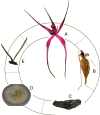Orchid conservation: from theory to practice
- PMID: 32407498
- PMCID: PMC7424752
- DOI: 10.1093/aob/mcaa093
Orchid conservation: from theory to practice
Abstract
Background: Given the exceptional diversity of orchids (26 000+ species), improving strategies for the conservation of orchids will benefit a vast number of taxa. Furthermore, with rapidly increasing numbers of endangered orchids and low success rates in orchid conservation translocation programmes worldwide, it is evident that our progress in understanding the biology of orchids is not yet translating into widespread effective conservation.
Scope: We highlight unusual aspects of the reproductive biology of orchids that can have important consequences for conservation programmes, such as specialization of pollination systems, low fruit set but high seed production, and the potential for long-distance seed dispersal. Further, we discuss the importance of their reliance on mycorrhizal fungi for germination, including quantifying the incidence of specialized versus generalized mycorrhizal associations in orchids. In light of leading conservation theory and the biology of orchids, we provide recommendations for improving population management and translocation programmes.
Conclusions: Major gains in orchid conservation can be achieved by incorporating knowledge of ecological interactions, for both generalist and specialist species. For example, habitat management can be tailored to maintain pollinator populations and conservation translocation sites selected based on confirmed availability of pollinators. Similarly, use of efficacious mycorrhizal fungi in propagation will increase the value of ex situ collections and likely increase the success of conservation translocations. Given the low genetic differentiation between populations of many orchids, experimental genetic mixing is an option to increase fitness of small populations, although caution is needed where cytotypes or floral ecotypes are present. Combining demographic data and field experiments will provide knowledge to enhance management and translocation success. Finally, high per-fruit fecundity means that orchids offer powerful but overlooked opportunities to propagate plants for experiments aimed at improving conservation outcomes. Given the predictions of ongoing environmental change, experimental approaches also offer effective ways to build more resilient populations.
Keywords: Orchid; conservation; conservation translocations; demography; genetics; mycorrhiza; pollination; reintroduction; restoration.
© The Author(s) 2020. Published by Oxford University Press on behalf of the Annals of Botany Company. All rights reserved. For permissions, please e-mail: journals.permissions@oup.com.
Figures





References
-
- Ackerman J, Montalvo A. 1990. Short- and long-term limitations to fruit production in a tropical orchid. Ecology 71: 263–272.
-
- Ackerman JD. 1983. Specificity and mutual dependency of the orchid-euglossine bee interaction. Biological Journal of the Linnean Society 20: 301–314.
-
- Ackerman JD, Ward S. 1999. Genetic variation in a widespread, epiphyte orchid: where is the evolutionary potential? Systematic Botany 24: 282–291.
-
- Albrecht MA, Maschinski J. 2012. Influence of founder population size, propagule stages, and life history on the survival of reintroduced plant populations. In: Maschinski J, Haskins KE, eds. Plant reintroduction in a changing climate. Seattle: Island Press/Center for Resource Economics, 171–188.
-
- Allee WC, Emerson AE, Park O, Park T, Schmidt KP. 1949. Principles of animal ecology. Philadelphia: Saunders.
Publication types
MeSH terms
LinkOut - more resources
Full Text Sources

